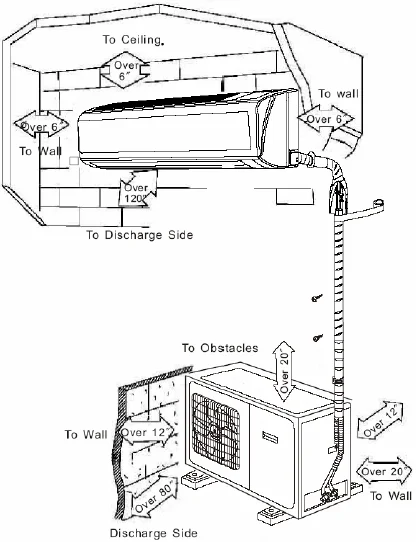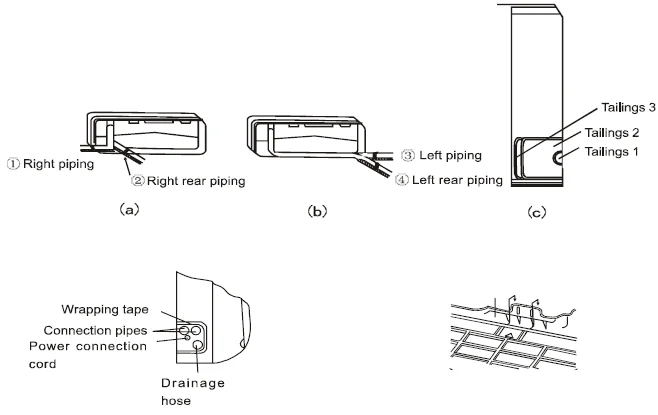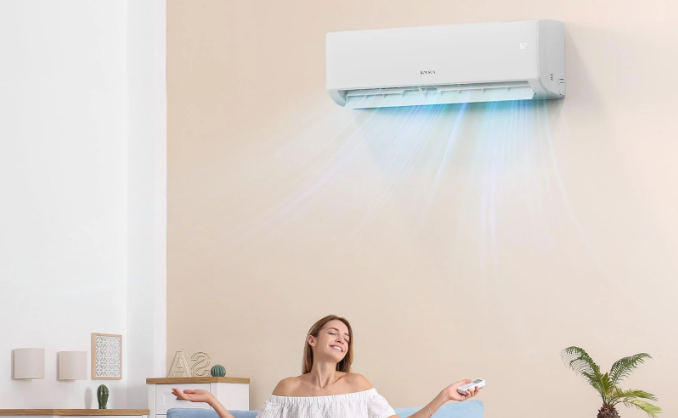Sea Breeze Mini-Split Heat Pump

UNIT PARTS & FEATURES
Indoor Unit
Outdoor Unit
INSTALLATION DIMENSION DIAGRAM

SAFETY WARNINGS
- Use Copper Wires only for the Power Supply.
- Risk of electric shock can cause injury or death. Disconnect all electric power supplies before servicing or installation.
- Do not use excessive torque on flare nuts during the connection of the refrigeration tubes, or the service valve on the discharge line may be damaged.
- Do not install the indoor unit in damp or wet locations.
- Electrical installation must be done by a qualified technician according to the instruction manual and in accordance with local electrical standards.
- Certified Power supply conductors must be used.
SELECT INSTALLATION LOCATION
CAUTION: The air conditioning unit must be installed by professional technicians.
BASIC REQUIREMENTS FOR INSTALLATION POSITION
Installation of either unit in the following locations may cause a malfunction.
Locations exposed to:
- Machine oil
- Flammable or corrosive gases
- High frequency waves (i.e., from radio equipment, medical equipment, etc.)
INDOOR UNIT LOCATION
Intake and outlet should not be obstructed.
The wall the unit is to be mounted on should allow for a clear hole for the condensation drain and the refrigeration lines.
The wall the unit is mounted on should be strong enough to bear the weight and vibration of the unit.
Allow for proper clearances around the unit – see installation dimension diagram. Location should allow easy access for maintenance and removal of the air filter.
Position the unit and remote control at least 3 feet from electric appliances such as televisions, radios, etc.
Keep the unit and remote out of direct sunlight and/or fluorescent lighting and away from any excessive heat source, steam, or flammable materials.
OUTDOOR UNIT LOCATION
Allow sufficient ventilation around the unit – see installation dimension diagram.
The air intake and outlet should not be obstructed.
Position the unit so that noise and outlet airflow will not inconvenience neighbors.
Position the unit on a solid foundation. Location should be able to withstand the full weight and vibration of the unit.
Installation should not be performed in the following locations exposed to: machine oil, flammable or corrosive gases, high-frequency waves (i.e., from radio equipment, medical equipment, etc.)
The installation location should be beyond the reach of children.
ELECTRICAL SAFETY REQUIREMENTS
The power supply must be of rated voltage via a special circuit for the air-conditioner. The power supply wire gauge is specified in page 9.
Applicable voltage range: the normal operation range of voltage is 90%~110% of the rated voltage.
Do not pull the power cable with excessive force.
System grounding to be completed by a licensed technician, using National Electrical Code procedures and UL materials. In the fixed line, there must be an electrical leakage protection switch and an air switch with sufficient capacity. The air switch shall also have the magnetic tripping and thermal tripping functions to achieve protection of both short-circuit and overload.
The minimum clearance between the air conditioner and the flammable surface is 5 ft.
GROUNDING REQUIREMENT
As an air-conditioning unit is of Class I electrical appliance, reliable grounding measures must be taken for it.
The green cable inside the air conditioner is for grounding and shall not be used for other purposes, nor can it be cut. Do not tighten with a tapping screw; otherwise electric shock will be caused.
The ground resistance shall be in conformity with the requirements of the state standard.
The user power supply shall have a reliable grounding terminal. It is prohibited to connect the grounding wire to the following items:
- Water Supply Pipe
- Gas Pipe
- Sewage Pipe
Other positions that are considered to be unreliable by professionals.
INDOOR UNIT INSTALLATION
INSTALL THE REAR PANEL-MOUNTING PLATE
Always mount the rear panel horizontally.
Hold the rear panel on the wall where you want the unit to be located and ensure that it is level using a plumb line or level. Once leveled, mark the screw locations on the wall.
Fasten the rear panel to the wall at the location marked using the screws supplied with the unit.
Insure that the panel has been mounted firmly to withstand the weight of the unit, for about 132 lbs, with the weight being evenly distributed by each screw.
INSTALL THE PIPING HOLE
Select the location for the piping hole – either left-positioned or right-positioned (see installation dimension diagram).
Make a piping hole in the wall approximately 2.5 inches in diameter at a slight downward slant (this ensures proper drainage).
Insert a piping-hole sleeve in the hole (i.e., PVC pipe) to prevent the connection piping and wiring from being damaged.
INSTALL DRAINAGE HOSE EXTENSION (OPTIONAL)
Drainage hose extension is included with the unit, for use if the attached drainage line is not long enough for your application.
Please note that the extension can be installed after the existing drainage pipe is fed through the wall, later in the installation process, if it is determined later that it is necessary.
Do not wrench or bend the drainage hose or extension.
WIRE THE INDOOR UNIT
CAUTION: All electrical wiring must be done by a qualified technician in accordance with local electrical codes.
A separate circuit breaker must be provided.
AC power for the indoor unit is provided by the power cable that runs between the outdoor unit and the indoor unit.
If a disconnect switch is required for the indoor unit, it must be properly rated. The disconnect switch may be installed by breaking the individual wires connected to pins (N1) and (3) of the control cable. See Table 1 for the recommended value.
Terminal board diagram
NOTE:
A power connection cable is provided in the installation kit (sold separately). If the cable is not of
sufficient length, it will be necessary to purchase cable for this purpose. Do not splice cable.
PREPARE REFRIGERATION LINES
Refrigeration lines and wiring can be routed from the indoor unit in several different ways using the cut-out access pieces on the back of the unit.
Bend the refrigeration lines carefully to the position needed to align with the drilled piping hole.
HANG INDOOR UNIT
Bundle the refrigeration lines, drainage hose, and wiring conduit attached to the indoor unit and wrap them securely for enough length to extend through the piping hole to the exterior of the building.
Note: leave the remainder unwrapped to allow for the remaining step in the installation of the outdoor unit and connecting the indoor unit to the outdoor unit.
Carefully push bundled lines through the piping hole.
Hang the unit on the wall by hooking the mounting slots of the unit over the upper tabs of the rear panel.
Check to make sure the unit is properly secured – it should feel firmly attached to the wall, and you should not be able to slide it to the right or left.
OUTDOOR UNIT INSTALLATION
CONNECT REFRIGERATION LINES
Align the center of the piping flare with the relevant valve. Use standard A/C practices to attach the connection pipes to the proper pipes of the bundled lines coming through the wall from the indoor unit.
Tighten the flare nut of the connection pipes using a spanner and a torque wrench. (see diagram)
Note:
Do not over-tighten flare nuts, or the connection may be damaged.
The unit is charged with enough R410A refrigerant for a standard designed length. For longer line set lengths additional charge must be WEIGHED in per Table 2.
INSULATE/BUNDLE REFRIGERATION LINES AND WIRING
Individually insulate all refrigeration lines and condensation drainage hoses to ensure that they do not sweat. This will help to maintain the unit at its proper capacities.
Once all lines have been properly insulated, bundle the refrigeration lines with the wiring conduit and wrap securely to complete the run to the outdoor unit.
Note:
The condensation drainage hose should be left free of the bundled lines in order to drain properly.
INSTALL OUTDOOR CONDENSATION DRAINAGE HOSE
When the heat pump unit is heating or defrosting, wastewater forms in the outdoor unit. This can be drained off using the outdoor drain elbow and hose provided.
Insert the drain elbow into the hole on the base plate as shown.
Join the drain hose to the elbow and turn so that the water drains to the desired location.
WIRE THE OUTDOOR UNIT
CAUTION:
A wrong wiring connection will cause an electrical malfunction.
Do not pull the wire when it is fixed with a wire clamp.
CAUTION: DO NOT CROSS WIRE.
TESTING
NOTE:
Installation MUST be complete prior to testing.
System MUST be tested prior to operation.
LEAKAGE TEST
Use standard A/C practices to properly check refrigeration tubes and connections for any leaks prior to system start-up.
AIR PURGING AND PRESSURE TEST
Remove the bonnet (cover) of the gas valve on the outdoor unit.
Charge the system with Nitrogen to 100 PSI and check for leaks.
Evacuate Nitrogen.
Connect the gas valves of a vacuum gauge, vacuum pump, and outdoor unit(see diagram). Start the vacuum pump and allow it to run
for at least 30 minutes at a level of 500 microns or less.
Shut off the vacuum and continue to monitor the vacuum gauge for another 15 minutes. The pressure should not rise above 800 microns.
If a vacuum of 500 microns cannot be obtained, or if it rises above 800 microns during the 15-minute monitoring period, pressurize the system with nitrogen and look for leaks. Repair any leaks that are found and repeat the vacuum testing.
Close the valves to the vacuum pump and gauge and disconnect from the outdoor unit.
Tighten the bonnet (cover) of the gas valve and open the gas and liquid valves completely.
SYSTEM TESTING
Before testing the system, ensure that the cut-off valves of the connection pipes are opened and that all debris (such as packing scraps, debris, etc.) is clear from the unit.
Switch on the power to the system and press the ”ON/OFF” button on the remote control to activate the indoor unit.
Press the ”MODE” button repeatedly, taking a moment on each setting to ensure that the system functions in all modes.
If the remote control is lost, an emergency run operation can be initiated by pressing the button in the upper right corner of the indoor unit under the cover panel.
INSTALLATION VERIFICATION
- Have both units been securely and firmly installed?
- Are all piping connections secure?
- Have the refrigeration lines been sufficiently insulated?
- Have you verified the length of the connection pipes and the refrigerant capacity?
- Have you conducted all leakage and system tests?
- Does the unit drain properly?
- Are all electrical connections in compliance with local standards?
- Has the unit been properly grounded?
- Is the power cord as specified?
- Are all air inlets and outlets free from obstruction?
PRINCIPLE
COOLING MODE
Principle:
The air conditioner absorbs heat from indoor air and transmits it outdoors for discharge, hence to decrease the indoor ambient temperature. The cooling capacity decreases with the rise of outdoor ambient temperature.
Anti-freeze Function:
If the air conditioner is running under low-temperature cooling mode, frost will appear on the surface of the indoor heat exchanger. When the temperature of the indoor heat exchanger is decreased to 32℉ or below, the microcomputer of the indoor unit will stop the compressor to protect the complete unit.
HEATING MODE
Principle:
The air conditioner absorbs heat from outdoor air and transmits it indoors for emission, hence increasing the air temperature in the room. The heating capacity decreases with the reduction of the outdoor ambient temperature.
It takes only a short time for this type of hot air circulating system to increase the indoor temperature. Use this air conditioner with other heating equipment if the outdoor temperature is extremely low.
Defrost:
When the outdoor temperature is low but the humidity is high, the heat exchanger of the outdoor unit may frost after the air conditioner has run for a period of time. This will decrease the heating effect.
In this case, the auto defrost function will be activated, and the heating mode will temporarily stop for 8-10 minutes.
Both the indoor fan and outdoor fan will be stopped during auto defrost.
During defrost, the indicator on the indoor unit will blink, and steam might flow from the indoor unit. This is caused by the defrost mode. Heating mode will automatically resume upon completion of the defrost process.
Anti-Draft Protection:
If the following conditions are present, the control circuitry in the unit will prevent the indoor fan from operating:
- Heat mode (delay 3 minutes).
- Auto defrost (delay 3 minutes after defrost cycle has completed).
- If the outdoor ambient temperature falls below 20 ℉, the indoor fan will not operate.
For more Manuals by Blogs, visit ManualsLibraryy
Sea Breeze Mini-Split Heat Pump-FAQs
What is a mini-split heat pump?
A mini-split heat pump is a ductless system that provides heating and cooling for specific rooms or zones. It consists of an outdoor compressor and one or more indoor air-handling units, offering flexible and efficient climate control.
What are the disadvantages of a mini-split heat pump?
Some drawbacks include higher upfront costs, visible indoor units that some may find unattractive, and potential inefficiency if the units are oversized or poorly placed.
How much does a mini-split heat pump cost?
Installing a mini-split system for a 1,000 sq. ft. space typically costs between $2,000 and $10,500, depending on the brand, model, and installation complexity.
Do mini-splits use a lot of electricity for heating?
No, mini-splits are generally energy-efficient. They use around 1,000 to 7,500 watts for heating, depending on outdoor temperature, system size, and the number of rooms being conditioned.
How many mini-split units are needed for a 2,000 sq. ft. house?
A 2,000 sq. ft. home usually requires 3–4 indoor units or a system with 36,000–48,000 BTU capacity to ensure balanced heating and cooling.
Do mini-splits work in 100-degree weather?
Mini-splits perform well in moderate climates but can lose efficiency when temperatures exceed 95–100°F or drop below freezing. Proper sizing and installation can help maintain performance in extreme conditions.
Which houses are not suitable for heat pumps?
Homes with poor insulation or single-pane windows are not ideal for heat pumps. Energy loss in such homes reduces system efficiency and increases operating costs.
Which is better, a window AC or a split AC?
Split ACs are generally more powerful, quieter, and better at distributing cool air compared to window ACs. They’re ideal for larger rooms or whole-home climate control.
What is the lifespan of a mini-split system?
A quality mini-split heat pump typically lasts 10 to 15 years with proper maintenance and regular servicing.





